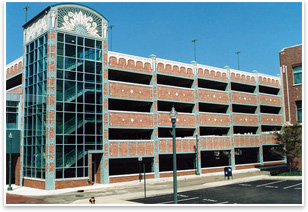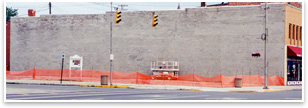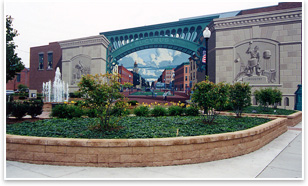
| Trompe l’Oeil Artist Brings Beauty to Urban Spaces
Summary: Artist Eric Grohe partners with architects, designers, art commissions, and community representatives to create large-scale three-dimensional mural art that transforms façades into vivid three-dimensional environments. Grohe says he creates his art to “involve, challenge, and inspire the viewer; not simply adorn, but integrate with its architectural surroundings.”
Grohe says his paintings connect with the architecture on many levels. “Architecture is one of those great civilizing factors. Architecture tells you about the continuum of a society with buildings . . . [communicating] in a way that shares the goals of mankind and shows us how we know ourselves. All of a sudden, here I am doing these big exterior things that have that ability to continue communication.”
Combining passions
Grohe’s advice for incorporating murals into design projects is familiar to architects: “Get us involved early. Advanced planning reduces costs and provides time for inspiration and design refinement.” Grohe says projects take four to six months to design and six months to a year to execute. He also points out the cost savings that result from eliminating the need for surface and finish treatment that he provides through his artwork. Studied process
Grohe also takes his cues from the building and their surrounding context. “Of course, if it’s something we’re taking over and doing the entire exterior, we look at the gross environment—the regional styles and materials and period styles,” he says. ”There are a lot of qualities of buildings in architecture that people just feel comfortable with.” That is why, he explains, there are many archways in his work. “That’s something that people just feel good about.”
|
||
Copyright 2007 The American Institute of Architects. All rights reserved. Home Page |
||
news headlines
practice
business
design
recent related
› Deck the Walls on a Budget
View Grohe’s Web site to see more of his work, with detailed project description, and before and after photos. He says even architects have trouble discerning a building’s real-life architectural features from those he has painted!
Grohe recently finished a mural at the Cempaka International School in Kuala Lumpur, Malaysia, where he was invited to teach students the art of mural painting. They are now considering a possible 40,000-square-foot façade in Dubai and are in the design phase of work on a 51-foot dome at a new Native American museum in Palm Springs, Calif., which is affiliated with the Smithsonian Institution. There, Grohe is looking forward to taking advantage of a curved surface with an eight-foot diameter oculus “to do things that are impossible to do from a three-dimensional standpoint on a two-dimensional surface.”
Grohe has been featured in numerous periodicals, magazines, and television broadcasts, and is frequently invited to lecture. His work has been a multiple winner in the Signs of the Times international mural competition, and, in 2002, he won both Best of Show and First Place. He says he counts among his most cherished honors his awards from the American Institute of Architects.
AIArchitect thanks Kathy Grohe for her assistance with this article.
Captions:
Image 1:
Mural Demonstration Cempaka International School, Kuala Lumpur, Malaysia. Eric and Kathy Grohe were invited there to teach students the art of mural painting.
Image 2: Students of the Cempaka International School, Kuala Lumpur, Malaysia, pose in front of their work.
Image 3 and image 4: Cornerstone Square, Parking Facility, for the State of Ohio and City of Canton. “Rarely does a parking garage become a visual asset to its community. In this case, however, the gray concrete garage was transformed into an award-winning edifice, which now complements the surrounding architecture and is the object of civic pride.”
Image 5 and image 6: Bucyrus, Great American Crossroad, for the Bucyrus Area Community Foundation, Bucyrus Downtown Revitalization Committee. The artist notes, “Dominating the main square of town, this once gray, soiled wall and gravel parking lot have become both a dramatic entrance to the city as well as a backdrop for numerous concerts and civic events. Over 80 local citizens posed for the figures in the mural, which depicts this same square early in the last century.”

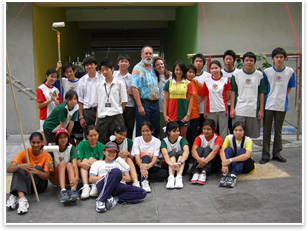
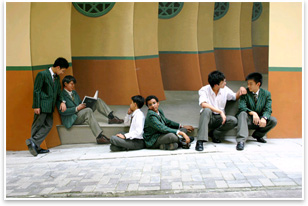 The murals also present communities with the opportunity for renewal and revitalization. “Maybe by the third or fourth project it was clear that this is more than just a big picture. It has a lasting effect on a community, and I better be very sober about the qualities it contains and what those should be for the culture outcome.”
The murals also present communities with the opportunity for renewal and revitalization. “Maybe by the third or fourth project it was clear that this is more than just a big picture. It has a lasting effect on a community, and I better be very sober about the qualities it contains and what those should be for the culture outcome.”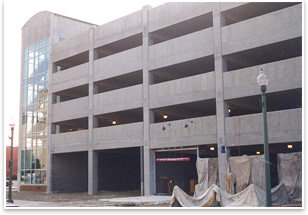 The murals, Grohe notes, are important value-added solution for
communities facing unattractive façades and blight. Grohe
notes he uses Keim Mineral Paint for exterior work, a colorfast (over
100 years), non-toxic, “green” product. For a parking
garage in Canton, Ohio, where the budget called for “a
big gray thing in the middle of an area that was brick, terra cotta,
and fancy stone work of an earlier era,” Grohe
says he painted 25,000 square feet of brick, fancy
stone and iron work, statuary, and other elements to make it a centerpiece
of its corner of town.
The murals, Grohe notes, are important value-added solution for
communities facing unattractive façades and blight. Grohe
notes he uses Keim Mineral Paint for exterior work, a colorfast (over
100 years), non-toxic, “green” product. For a parking
garage in Canton, Ohio, where the budget called for “a
big gray thing in the middle of an area that was brick, terra cotta,
and fancy stone work of an earlier era,” Grohe
says he painted 25,000 square feet of brick, fancy
stone and iron work, statuary, and other elements to make it a centerpiece
of its corner of town.